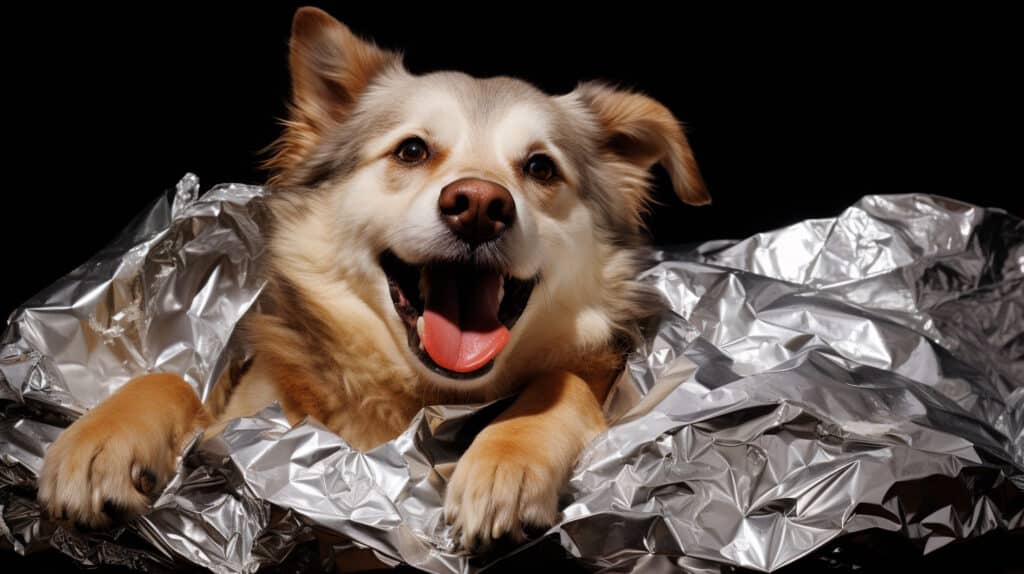Key Takeaways
- Aluminum foil is not generally toxic to dogs alone
- Obstruction is the most likely complication of eating a large chunk of aluminum foil
- Clinical signs that your dog has an obstruction include intractable vomiting and abdominal pain
- Aluminum foil can also pose a choking hazard to your dogs, so you should prevent your dog from gaining access to it where possible
I doubt you think of aluminum foil as a tasty treat, but your dog may have other ideas, particularly if it’s just been wrapped around some roast beef.
Aluminum foil, also known as aluminum foil or tin foil in some parts of the world, is commonly stolen from the trash or off the kitchen counter by peckish pooches.
Tin is no longer used to make foil, so all foil contains aluminum. Small amounts may pass through your dog’s gut without any major issues; larger pieces (particularly foil rolled into a ball) may pose a choking hazard or even cause intestinal obstruction and require surgical removal.
Read on to find out more about what to do if your dog has eaten aluminum foil and when to contact your veterinarian.
How much is Aluminum Foil toxic to dogs?
Luckily, aluminum foil isn’t generally toxic to your dog per se, but it may contain toxic foods when your dog gets their paws and jaws on it.
It’s highly unlikely that your dog would absorb a toxic or poisonous dose of aluminum through their intestinal tract. The foil typically passes through the gastrointestinal tract without being digested or absorbed.
Some toxic foods that aluminum foil is typically used for when cooking are chocolate, garlic, and onions. Many people use aluminum foil to wrap cooked bones for the trash, which, if eaten, can cause damage to your dog’s gut and even a perforation, leading to peritonitis in severe cases.
What would happen if my dog ate aluminum Foil?
There are some dangers if your dog eats aluminum foil aside from toxicity. Large amounts or balls of aluminum foil can pose a major risk for choking in our canine companions, It can also adhere to your dog’s esophagus as they attempt to swallow it and cause irritation, leading to coughing and retching.
Intestinal obstruction is another risk, and this is a life-threatening emergency that requires surgery. Aluminum foil can accumulate in the stomach or attempt to move its way through the small intestine before causing a blockage.
Gastrointestinal upsets are sometimes seen with aluminum foil ingestion, but it’s not caused by the foil itself but by the food item wrapped inside. High-fat foods are the typical cause of these tummy upsets.
When Should I Take My Dog To the Vet?
There’s no harm in contacting your veterinarian if you know your dog has eaten aluminum foil for advice tailored to your dog’s specific situation.
Some signs of your dog having an obstruction or throat irritation from swallowing foil that indicates you should take your dog to your veterinarian include coughing or signs of distress, vomiting, abdominal pain, lethargy, or constipation.
If you see any of these signs, then you should contact your veterinarian immediately for an emergency appointment.
What if my dog ate plenty of aluminum foil but seems fine?
For many pooches, you won’t see any signs if the aluminum foil passes through your dog’s intestinal tract easily with minimal inflammation.
If your dog is choking, then it’s likely that they will show signs quite quickly. Conversely, if your pooch develops an obstruction, then you’re likely to see lethargy, abdominal pain, and vomiting, and you should contact your veterinarian immediately.
Signs that my dog ate an aluminum foil
Aside from the obvious missing foil, if it’s caused problems, you may see the following signs. These signs include:
Signs of choking or throat irritation include:
- Unable to breathe
- Coughing
- Retching that’s unproductive
- Hacking
- Repeated swallowing
- Drooling
- Difficulty swallowing/eating
These signs can indicate the possibility of intestinal obstruction:
- Vomiting
- Inapdogence
- Lethargy
- Constipation
- Abdominal pain
Some signs that can indicate a tummy upset from rich foods or intestinal trauma:
- Diarrhea that doesn’t resolve in 48 hours
- Blood in feces
- Lethargy that doesn’t resolve
How do veterinarians treat dogs that have eaten aluminum foil?
If your dog ate foil, your veterinarian will thoroughly examine your dog to ascertain if they have abdominal pain or if they are choking on the foil. Your veterinarian may elect to endure vomiting to bring up the foil to prevent toxicity due to dangerous foods if there are food products such as chocolate or grapes within the foil.
Sometimes, your veterinarian may advise taking the watch-and-wait approach to monitor if the foil passes safely in the following 48-72 hours without adversely harming your dog.
If your vet is concerned about a blockage in the stomach or intestines, then they will perform blood tests, start your dog on intravenous fluid therapy, and perform X-rays to see the ball of foil and also a gas pattern that indicates an obstruction.
Once an X-ray is taken, if the foil is in the stomach, your vet may choose to perform an endoscopy to retrieve the blockage, but if this isn’t successful, then your dog will need to undergo surgery to remove the foil as they would if the foil is obstructing the intestines.
How Long Will It Take My Dog to Recover?
Recovery time depends on whether the foil has become an obstruction or not. Some dogs won’t show any clinical signs at all, while others may have a tummy upset that leads to diarrhea. This should be resolved within 48 hours.
Dogs that have an intestinal obstruction from aluminum foil that need surgical intervention to treat the problem will take a number of weeks to recover from the procedure fully. Most of these dogs are hospitalized for a few days after the surgery.
Final Woof
If your dog shows clinical signs of vomiting, constipation, lethargy, or abdominal pain after ingesting aluminum foil, then you should take them to your veterinarian as a matter of urgency.
Prevention is better than cure, so you should prevent your dog from accessing aluminum foil in the first instance. Aluminum foil can cause problems for some pooches, so it’s best to prevent them from gaining access by not leaving it on the countertop after cooking and having a covered trash can to prevent your dog from gaining access.


